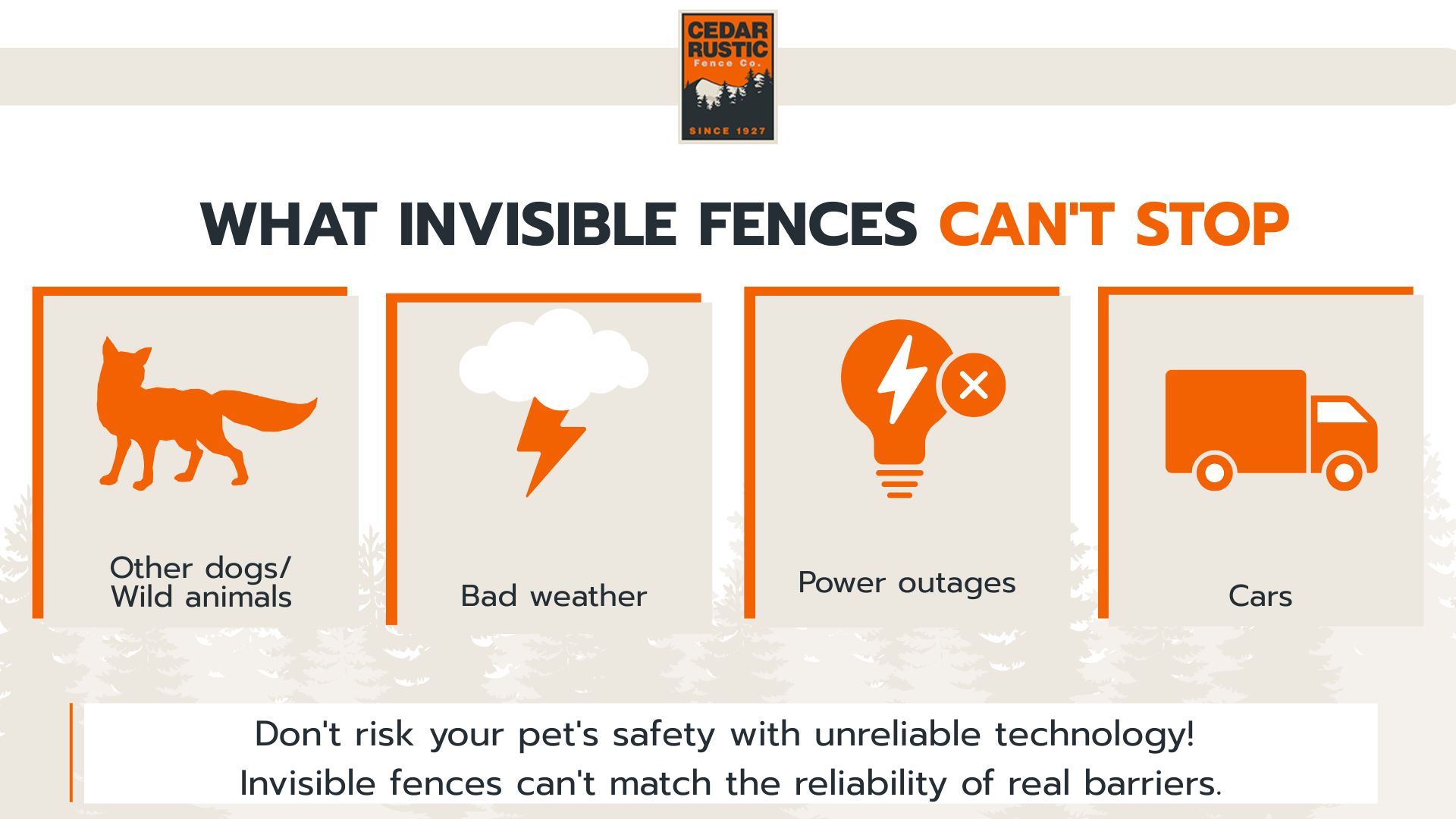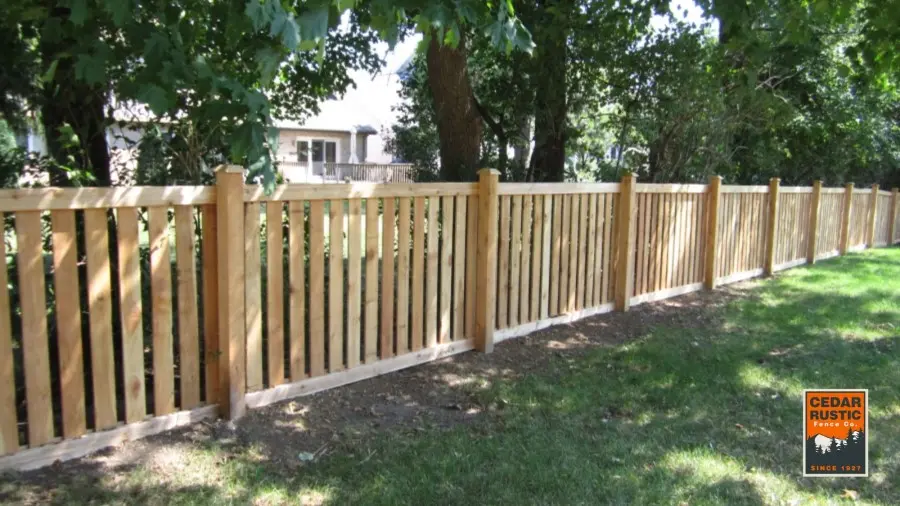You're watching your dog play in the backyard when suddenly they spot a squirrel and bolt toward the street. This heart-stopping moment is why many Chicagoland homeowners consider fencing options, but the choice between an invisible electric fence and traditional ones isn't as simple as it seems.
As Chicagoland dog fence installers with nearly 100 years of experience, the Cedar Rustic team has seen countless homeowners struggle with this decision — and witnessed the real-world consequences of choosing wrong.
In this guide, we explore how invisible fences actually work, share opinions from pet owners online, compare real costs, and present proven alternatives that keep your pets safe.
Understanding Invisible Fences: How They Work

An invisible fence is a pet containment system that creates an underground boundary using buried wires that connect to a transmitter box in your garage or basement. Your dog wears a receiver collar that delivers a correction when they approach the boundary line.
- Underground wire loop: Buried 3-4 inches deep around your designated area. The wire must form a complete circuit back to the transmitter, or the system won't work.
- Transmitter box: Plugs into a standard outlet and sends radio signals through the wire. Most boxes mount on walls in garages or basements and require constant power to function.
- Receiver collar: Your dog wears this special collar that detects the signal. It beeps first as a warning, then delivers a static shock if your pet continues toward the boundary.
- Training flags: Visual markers placed along the boundary during the 2-4 week training period. You'll walk your dog near these daily until they learn to avoid the area.
- Battery requirements: Collar batteries need replacement every 3-4 months at $15-25 each. Without fresh batteries, the entire system fails with no warning.
Wired Fence vs. Wireless Systems
- Wired systems: Allow you to customize the exact boundary shape by placing wire where needed. However, any break in the wire, such as from lawn equipment or ground settling, disables the system altogether.
- Wireless systems: Create only circular boundaries from a central transmitter with a limited range. Signal interference from metal objects, slopes, or weather makes these even less reliable than wired versions.
While the technology seems straightforward, these systems have inevitable limitations that manufacturers rarely advertise upfront.
The Hidden Dangers Pet Owners Discover Too Late
Many pet owners only discover the serious problems with invisible fence systems after spending thousands on installation and training.
Developed Behavioral Problems
Electric dog fences often develop anxiety and aggression issues. They learn to associate the shock with whatever they see at that moment; often, other dogs, children, or delivery people. This creates fear-based reactions that can linger for years. In extreme cases, some dogs become so stressed that they refuse to go outside at all.
The Escape Problem That Gets Worse
When discussing invisible fences on Reddit, one pet owner received overwhelming warnings from other users. The consensus was clear:

High-prey-drive dogs like Brittanys will chase through any shock level when they spot wildlife. The real danger comes next: once outside, most dogs won't return home because crossing back means another shock. Your pet becomes trapped outside the boundary meant to protect them.
When Protection Becomes Attack
A particularly disturbing pattern emerges in user discussions about invisible fences triggering aggressive responses. One Reddit user shared:

Unfortunately, these aren't isolated incidents. They represent fundamental flaws in how invisible fence systems work in real-world scenarios.
How to Choose the Best Fences for Dogs
A physical fence is always the best choice; it works 100 percent of the time, regardless of your dog's excitement level or what's happening outside. There's no training period, no batteries to replace, and no risk of system failure during power outages. Most importantly, physical barriers protect your pet from external threats while keeping them securely contained.
Height and Design Considerations
For most dogs, a 4-foot fence works well for containment, but big dogs or jumpers need a fence that is at least 6 feet tall. Cedar fences offer privacy and natural beauty that enhances your outdoor space, while vinyl options provide durability with virtually no maintenance required over decades.
Added Benefits Beyond Pet Containment
Physical fences don’t just benefit your furry friends. They increase property value by 5-7 percent on average. Use them to create private outdoor living spaces, reduce noise from neighbors, and provide security for your entire family. Unlike invisible fence systems, they also protect your investment by lasting 30+ years when they’re installed properly.
The Real Cost Comparison: Invisible Fence or Real Fence
Invisible fence systems come with ongoing expenses that most pet owners don't anticipate. For example, collar batteries cost $60-100 annually for replacement. Wire repairs from lawn equipment or ground settling average $200-300 per incident. If your first collar breaks, or you need additional collars for another pet, expect to pay $100-300 each.
Professional training adds another $200-500 if your DIY attempts fail. Many homeowners also face liability costs; if your dog escapes and causes an accident, you may face thousands in veterinary bills or legal expenses on top of the emotional trauma you must endure.
The One-Time Investment Advantage
Quality physical fences are truly "install and forget" solutions. A properly installed fence has no ongoing costs beyond optional aesthetic choices. How long cedar lasts depends on the climate, but you can expect a minimum of 15-30 years. Vinyl fences can last even longer with zero maintenance requirements.
Property Value and Insurance Benefits
Here's what changes the math completely: a $5,000 fence typically adds $3,500 to your home's value, making your real cost only $1,500. Did you know that many insurance companies offer discounts for secured yards? When you factor in these benefits, along with the lack of ongoing costs, physical fences often cost less than invisible systems within just three years.
Budget-Friendly Dog Fence Alternatives
If the upfront cost is your primary concern, consider affordable fence options, such as chain link or smaller enclosed areas, rather than full-yard fencing. Many fencing companies offer payment plans to spread costs over time.
When you calculate total ownership costs, including maintenance, replacement parts, and home value impact, physical fences prove more economical than their electric counterparts.

Making the Right Choice for an Electric Fence
We understand that every property and pet situation has unique needs, but Chicago's specific challenges make the decision clearer for most homeowners.
Most important concern: Many Chicagoland HOAs prohibit invisible fences due to liability concerns. Always check your association rules before investing in any fence system.
- Freeze-thaw damage: Chicago's brutal temperature swings cause ground shifting that breaks invisible fence wires. One crack in the wire means your entire system stops working until you locate and repair the break.
- Snow removal hazards: Snowplows and shoveling frequently cut buried wires along driveways and sidewalks. Each repair costs $200-300 and leaves your pet unprotected until it’s fixed.
- Power outage risks: Ice storms and summer thunderstorms regularly knock out power in Chicagoland. When electricity fails, so does your invisible fence, but physical fences keep working.
- Year-round reliability: Physical fences handle everything from -20°F winters to 95°F summers without any electronic components to fail. They work the same whether it's sunny or stormy.
- Neighbor relations: Visible boundaries prevent disputes about property lines and keep neighborhood dogs separated. Invisible fences often create tension when your dog barks at others who can't see the boundary.
Invisible fences have limited applications, such as protecting garden areas or flower beds from your own pets, for example. But for primary pet containment near busy streets or in unfenced neighborhoods, the risks far outweigh any convenience.
In many cases, you’ll need to prioritize your dog’s long-term safety and peace of mind over short-term convenience.












